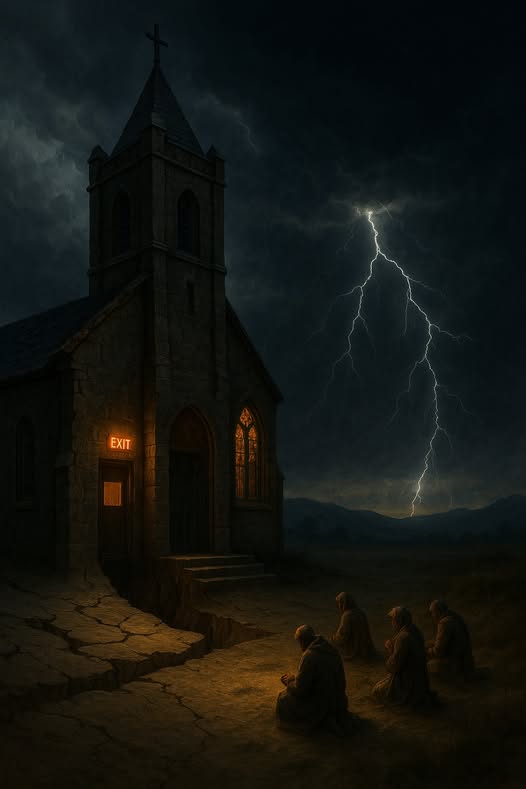
The modern Church has been deeply shaped by the belief in a Pre-Tribulation rapture. For many, it’s not just one view among others, it’s the foundation of their entire understanding of the end times. It promises rescue before tribulation, escape before hardship, and a clear timeline of events that keeps God’s people out of harm’s way. But what if that expectation does more harm than good?
Pre-Trib theology doesn’t just risk embarrassment when predictions fail. It warps the Church’s posture toward suffering, distorts biblical prophecy, weakens discipleship, and opens the door for deception. If we are truly approaching the end of the age, these distortions are not just unfortunate; they are dangerous.
Where Did Pre-Trib Come From?
Despite its popularity today, the doctrine of a Pre-Tribulation rapture is a recent invention. The early Church did not teach it. The apostles did not preach it. Church fathers such as Irenaeus, Tertullian, and Justin Martyr all wrote about persecution, endurance, and Christ’s visible return after tribulation. None spoke of a secret rapture to remove believers beforehand.
The modern Pre-Trib view can be traced to the early 1800s. A young Scottish girl named Margaret MacDonald claimed to receive a prophetic vision about believers being taken up before a time of judgment. Her vision gained traction in charismatic circles, but it was John Nelson Darby, leader of the Plymouth Brethren movement, who systematized the doctrine. Darby’s framework introduced a sharp distinction between Israel and the Church, divided history into dispensations, and made the rapture the trigger for the final tribulation period.
Darby’s teachings reached the United States and gained widespread influence, especially after the publication of the Scofield Reference Bible in the early 1900s. Scofield included Pre-Trib interpretations directly in the study notes, leading generations of Christians to treat those interpretations as biblical fact.
How It Took Hold
In the decades that followed, Dallas Theological Seminary became the intellectual and theological stronghold of Pre-Trib rapture teaching. Founded in 1924, Dallas trained generations of pastors, scholars, and missionaries in this system, embedding it in pulpits, seminaries, Bible colleges, and denominational statements of faith across the evangelical world. Prominent figures like Lewis Sperry Chafer, John Walvoord, and later Charles Ryrie and Tim LaHaye continued to promote and defend the doctrine.
From books like The Late Great Planet Earth to the Left Behind series, Pre-Trib theology became cultural default for many Christians—not because it was ancient, but because it was new, systematized, and aggressively taught.
What Did Paul Really Mean?
Many defenders of the Pre-Tribulation rapture point to Paul’s words in 1 Thessalonians 4:17, where he says believers will be “caught up… in the clouds to meet the Lord in the air.” This is the primary passage used to support the idea of a sudden removal of the Church before tribulation. But a closer look at the context and language reveals something very different.
First, Paul is not introducing a new doctrine of escape. He is comforting grieving believers who feared their loved ones who had died would miss out on Christ’s return. His message is one of hope and resurrection, not secret removal. The focus is on the return of the King, not the departure of the Church.
Second, the phrase “to meet the Lord in the air” uses a specific Greek word for “meet”, apantēsis, which was commonly used in the ancient world to describe the act of a city going out to greet a conquering king or visiting dignitary and escorting him back into the city. This is not about leaving with him. It is about welcoming his arrival and returning with him in triumph. The same word is used in Matthew 25:6 in the parable of the ten virgins, where the bridesmaids go out to meet the bridegroom and then come back in with him for the feast.
Paul’s teaching in 1 Corinthians 15 follows the same pattern. The trumpet sounds, the dead are raised, and the living are transformed. But there is no mention of leaving the earth or avoiding tribulation. It is a resurrection passage, not an evacuation one.
The early Church read these texts as descriptions of Christ’s visible return at the end of the age, not as proof of a two-stage coming. The idea that Christ would come secretly, then come again publicly, is a much later invention. Paul, like Jesus, pointed his readers toward endurance until the final return, not disappearance beforehand.
More Than Just a Debate About Timing
It is true that Christians have long debated the timing and details of Christ’s return. Some are postmillennial. Others are amillennial. Some take a historicist view of Revelation, others a futurist or idealist one. These discussions are part of the broader diversity within the Church, and faithful believers can land in different places.
But the Pre-Tribulation rapture is not just one option among many. It is not merely a different reading of symbols or a disagreement about the order of events. It introduces an entirely new event into the biblical timeline, a secret coming of Christ to remove the Church before tribulation, that was not taught by Jesus, not expected by the apostles, and not found in Church history before the 1800s.
This teaching does more than adjust a timeline. It reshapes how the Church understands suffering, perseverance, and mission. It redefines the role of the Church in the last days, and in doing so, it creates a spiritual posture of escape instead of endurance. That is not just a harmless variant. It is a distortion with consequences.
A Pattern of False Restorations
It’s also worth noting the time period in which Pre-Tribulation theology arose. The early to mid-1800s saw a surge of new religious movements claiming hidden insight or special revelation. Mormonism began in 1830, Jehovah’s Witnesses in the 1870s, and the modern Pre-Tribulation rapture in the 1830s and 40s. Each claimed to restore something lost. Each relied on visions, reinterpretations, or extra-biblical systems. And in each case, followers became fiercely defensive, often reacting to criticism with a level of loyalty that exceeds what they show to core doctrines of the faith.
That same defensive fervor surrounds Pre-Trib today. It is often shielded not by Scripture, but by fear, emotional appeals, and cultural repetition. When confronted with its historical origins or its theological problems, many respond not with reflection, but with resistance. That should concern us. It suggests that for many, Pre-Trib isn’t just a position. It has become a lens through which all of Scripture and all of history are interpreted. That’s not biblical faith. That’s conditioning.
Setting Dates and Failed Predictions
Alongside its rise, Pre-Trib thinking also fueled a culture of date-setting. From William Miller’s failed prediction of 1844 to later movements that circled years like 1988, 2000, and 2012, countless Christians have been told that the rapture was imminent on a specific timetable. Each failure left confusion, disillusionment, and in some cases, outright abandonment of the faith.
To be fair, most who hold to a Pre-Trib view today do not set dates. They insist the rapture is imminent but avoid predictions of exact years or days. Yet the system itself lends to that temptation. If the rapture can occur “at any moment,” then every world event, war, or earthquake becomes potential confirmation. The result is a cycle of hype and disappointment. Instead of grounding believers in patient endurance, Pre-Trib teaching has too often trained them to chase headlines, waiting for the next escape window rather than building deep faith that can withstand long delay.
Some Have Begun to Ask…
Some have begun to ask whether the rise of Pre-Trib theology was just a historical development or something more intentional. Could it be that the enemy, knowing the time is short, introduced a theology that sounds hopeful but removes the Church’s readiness to suffer deeply? Even if some Pre-Trib teachers acknowledge that persecution may occur before the rapture, the dominant framework still assures believers they will not be present when God’s greatest judgments fall. That promise of escape, rather than endurance, may be part of the great deception warned about in Scripture.
Whether through false prophecy, doctrinal drift, or misplaced trust in charismatic leaders, Satan has always tried to distort the Word of God to weaken God’s people. A doctrine that tells the Church it will not face the full refining fire of the last days may not be innocent. It may be part of the strategy to make her vulnerable when the hour of testing truly comes.
Theological Drift
At its core, the Pre-Trib view changes how people read the Bible. Passages that are clearly about perseverance, suffering, and endurance are reinterpreted as applying only to others, often to unbelieving Jews or those left behind. The Church is told it will escape the very testing that Scripture says it needs in order to be refined.
Instead of preparing the Bride for hardship, this teaching promises removal. Instead of strengthening faith under pressure, it offers an exit plan. But Jesus never called His followers to escape. He called them to take up their cross.
Discipleship That Can’t Endure
A Church trained to expect rescue is not a Church ready for resistance. Pre-Trib teaching creates shallow discipleship. Why build endurance if you won’t need it? Why develop spiritual muscle if you expect to be gone before the fight begins?
The result is a generation of believers ill-equipped to suffer, slow to serve, and confused when life gets hard. Many fall away when trouble comes, not because Christ failed them, but because they were told they wouldn’t be here for it.
If the End Times are truly beginning, then Pre-Trib theology may be one of the greatest liabilities the Church faces. A generation trained to expect escape will be blindsided when the pressure rises. Some will lose faith entirely. Others will compromise, thinking God must have changed His plan. And still others will be easy prey for leaders who promise stability, safety, or signs of divine favor.
This is how deception takes root. The antichrist doesn’t need to hide if Christians don’t expect him to be there. If the Church is told, “We won’t be here for that,” then by the time it happens, it’s already too late. He’ll be welcomed, not resisted.
The Real Cost of Being Wrong
Pre-Trib thinking can cause damage even when no suffering comes. While many who hold the view are sincere and active in ministry, the system itself often fosters passivity. It creates an outlook where long-term planning, justice work, or cultural engagement seem unnecessary. After all, if everything is about to end, why build for the future?
It also tends to fragment the Church. Believers who question the timeline are sometimes viewed with suspicion. Those who suffer now are told to simply hold on until the rapture, rather than being equipped to endure and persevere. In many circles, real ministry has been sidelined by speculation, elaborate timelines, and conferences that offer fear packaged as hope.
Protection Does Not Require Removal
One of the most damaging assumptions in Pre-Trib theology is the idea that God must remove the Church before He pours out His wrath. The argument often goes like this: “God has not appointed us to wrath, so we won’t be here during the Tribulation.” But this misreads what the Bible actually says about wrath, judgment, and protection.
When Paul wrote that believers are not appointed to wrath (1 Thessalonians 5:9), he was referring to eternal wrath, the final judgment that results in separation from God. That is the wrath we have been saved from through Christ. It does not automatically mean that we will be removed from the earth during times of temporal judgment or tribulation.
Throughout Scripture, God demonstrates His ability to preserve His people during judgment, not just by removing them, but by protecting them in the midst of it. Noah was preserved through the flood. Israel was shielded during the plagues on Egypt. The faithful remnant endured in exile. In Revelation, the servants of God are sealed and protected, not taken away, but preserved during God’s dealings with the earth.
The idea that God cannot allow His people to be present when He pours out judgment ignores the clear biblical pattern. His wrath is aimed at the unrepentant, not His covenant people. The Church is not appointed to wrath because it has been justified by the blood of Christ. But that does not mean it will be absent from the world when God judges it. It means the Church will be marked, protected, empowered, and refined, not forsaken.
This is where the Greek wording matters. In both John 17:15 and Revelation 3:10, the phrase tēreō ek (τηρέω ἐκ) is used. It literally means “to keep, guard, or preserve from within.” When Jesus prayed in John 17:15, “I do not ask that you take them out of the world, but that you keep them from the evil one,” He defined what tēreō ek means. It is not removal from the scene but preservation in the midst of it.
Some argue that in Revelation 3:10 the promise to be “kept from the hour of trial” must mean being removed from that time entirely. But the Greek phrase does not demand removal. The difference reflects context: in John 17 the danger is “the evil one,” while in Revelation 3 it is “the hour of trial.” In both cases, the promise is the same, not escape beforehand, but protection when the danger comes.
The Church is not promised evacuation. It is promised preservation.
Urgency Is Not Enough
The Church doesn’t need an escape plan. It needs courage. Jesus didn’t pray that His people would be taken out of the world. He prayed they would be protected in it. The apostles didn’t tell believers to look for the first flight out. They told them to endure, to stand firm, and to overcome by the blood of the Lamb and the word of their testimony.
Some who hold to the Pre-Trib view argue that it does not lead to complacency. They point to passionate evangelism, global missions, and a deep desire to see the fullness of the Gentiles come in before Christ returns. For many, the belief that the rapture could happen at any moment drives them to act with urgency and reach the lost.
There is sincerity in that position, and in the short term it often produces results. But urgency is not the same as endurance.
A mission built on escape is not the same as a mission rooted in suffering love. The kind of urgency produced by Pre-Trib thinking often burns hot, but not deep. When trouble comes, the urgency tends to fade. What remains is the underlying theology, and that theology has not prepared the Church to suffer, wait, or endure.
The challenge, then, is not about individual believers lacking zeal. It is that the framework itself is not built for what is coming. It pushes Christians to work while the sun is shining, but it does not prepare them to stand when the storm arrives. Evangelism becomes disconnected from discipleship. Energy is spent on reaching people quickly, but not necessarily preparing them to remain faithful when hardship and pressure follow.
The New Testament does not call the Church to quick success. It calls her to patient endurance. The harvest is real, but so is the furnace. Without a theology that embraces both, the Church will not last.
Grace Does Not Cancel Accountability
Some may ask, “If Pre-Trib believers are sincere and saved, why does any of this matter?” After all, salvation is by grace through faith, not by perfect doctrine. That much is true. But the question is not just about salvation. It is about responsibility.
Jesus warned in Matthew 18:6 that causing a young believer to stumble is not a small matter. James 3:1 reminds us that teachers will be judged more strictly. If a teaching leaves believers unprepared, fragile, or disillusioned when hardship comes, that is not harmless. It may not cost someone their salvation, but it can cause real spiritual harm, and God does not take that lightly.
Paul speaks of this in 1 Corinthians 3:13 to 15. Some teachers build with gold, silver, and costly stones. Others build with wood, hay, and straw. When the fire comes, each person’s work will be revealed. Some will receive reward. Others will suffer loss, though they themselves will be saved.
In other words, grace does not erase consequences. False expectations can damage others, and those who promoted them will give account. We are called not just to get people in the door, but to build strong, enduring disciples who can stand when trials come.
Conclusion
The Pre-Trib rapture may sound like comfort, but it leads to complacency, disillusionment, and vulnerability. It gives the enemy room to move, undermines the Church’s strength, and replaces preparation with presumption.
The time to build endurance is now. The time to teach truth is now. And the time to prepare the Church, not to flee, but to stand, is long overdue.
Discussion Questions
- What does expecting escape rather than endurance reveal about our understanding of suffering in the Christian life?
- Why did the early Church never teach a Pre-Tribulation rapture, and what changed in the 19th century to introduce it?
- How might belief in a Pre-Trib rapture shape a Christian’s response to persecution, hardship, or societal decline?
- In what ways can urgent evangelism become disconnected from long-term discipleship?
- What are the dangers of treating theological systems as untouchable or above critique?
- How does the promise of preservation in tribulation differ from the promise of removal?
- What role does fear play in the defense and promotion of Pre-Trib theology?
- How should Christians prepare spiritually if they expect to live through the trials described in Revelation?
- What does Revelation 3:10 mean in context, and does it require a Pre-Trib interpretation?
- How can the Church reclaim a theology of endurance without falling into fear or legalism?
Want to Know More?
- Joe Schimmel, Left Behind or Led Astray? (Documentary)
A detailed exposé of the origins of Pre-Trib rapture teaching. Traces its rise from John Nelson Darby and challenges its biblical and historical foundations with clarity and courage. - Joel Richardson, The Islamic Antichrist
Connects biblical prophecy to current global movements. Richardson offers a Post-Trib perspective that emphasizes endurance, testing, and spiritual discernment. - Leon Festinger, When Prophecy Fails
A groundbreaking sociological study of how religious groups react when predictions don’t come true. Shows how believers can double down on error when identity is built on false expectations. - Corrie ten Boom, Tramp for the Lord
A powerful personal testimony of suffering, faith, and spiritual victory through real tribulation. Corrie openly rejected Pre-Trib theology after watching how it failed others under Nazi rule. - N. T. Wright, Surprised by Hope
Refocuses Christian eschatology on resurrection and new creation rather than escapism. Challenges modern assumptions about heaven and emphasizes the Church’s mission to remain faithful. - Charles E. Hill, Regnum Caelorum: Patterns of Millennial Thought in Early Christianity
Surveys early Church eschatology and shows that Pre-Trib ideas were foreign to the first generations of Christians. A strong academic rebuttal to claims that the early Church taught Pre-Trib. - Robert H. Gundry, The Church and the Tribulation
A respected evangelical scholar dismantles the Pre-Trib position using Scripture, arguing for Post-Trib rapture while affirming biblical authority and inerrancy. - David Bercot, Dictionary of Early Christian Beliefs
A topical reference to what the early Church taught—including suffering, persecution, and the second coming. A valuable tool to show how far modern views have drifted from ancient faith. - John Piper (Editor), Suffering and the Sovereignty of God
A collection of essays highlighting the necessity of Christian suffering. Not about the rapture directly, but essential for correcting the comfort-centric theology that often feeds Pre-Tribism. - D. M. Lloyd-Jones, Spiritual Depression: Its Causes and Cure
Offers insight into the spiritual fallout that often follows disappointed hope. While not about eschatology, it is a vital pastoral resource for helping those disillusioned by failed end-times expectations.




